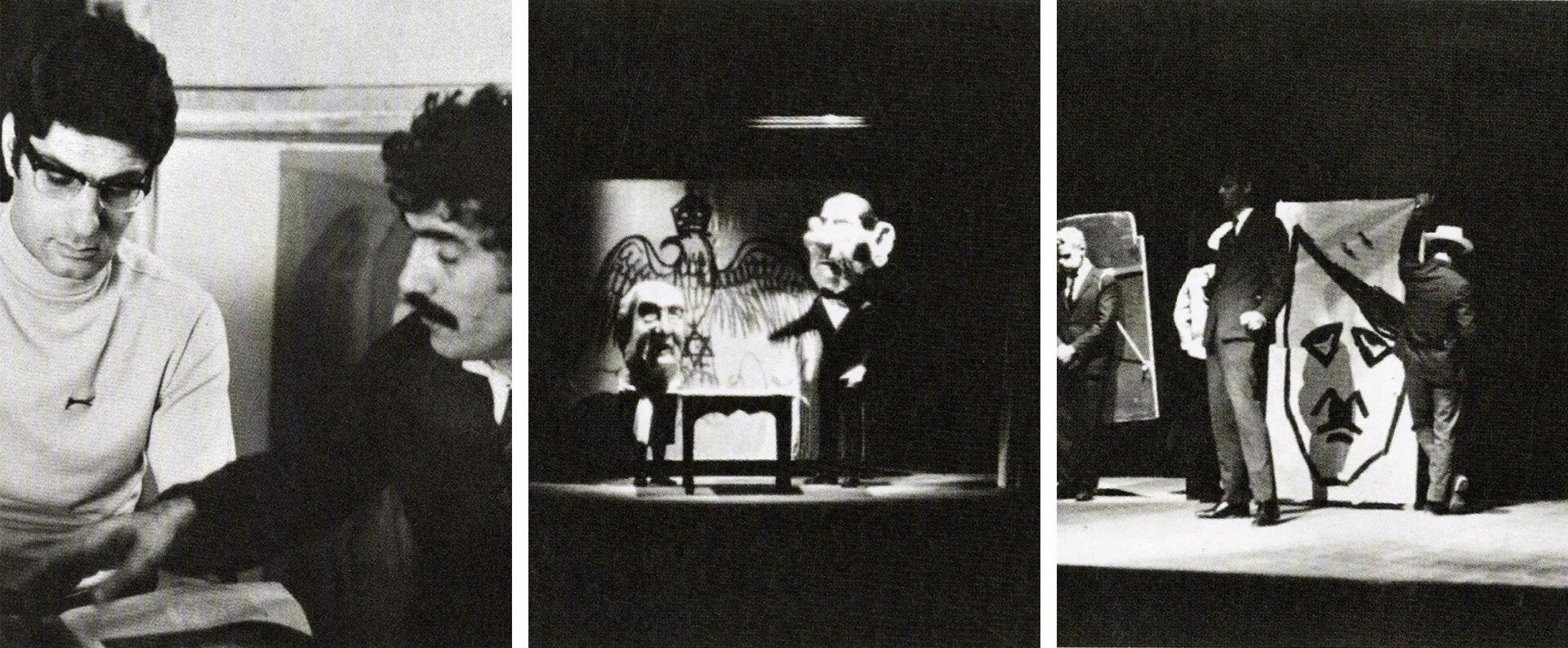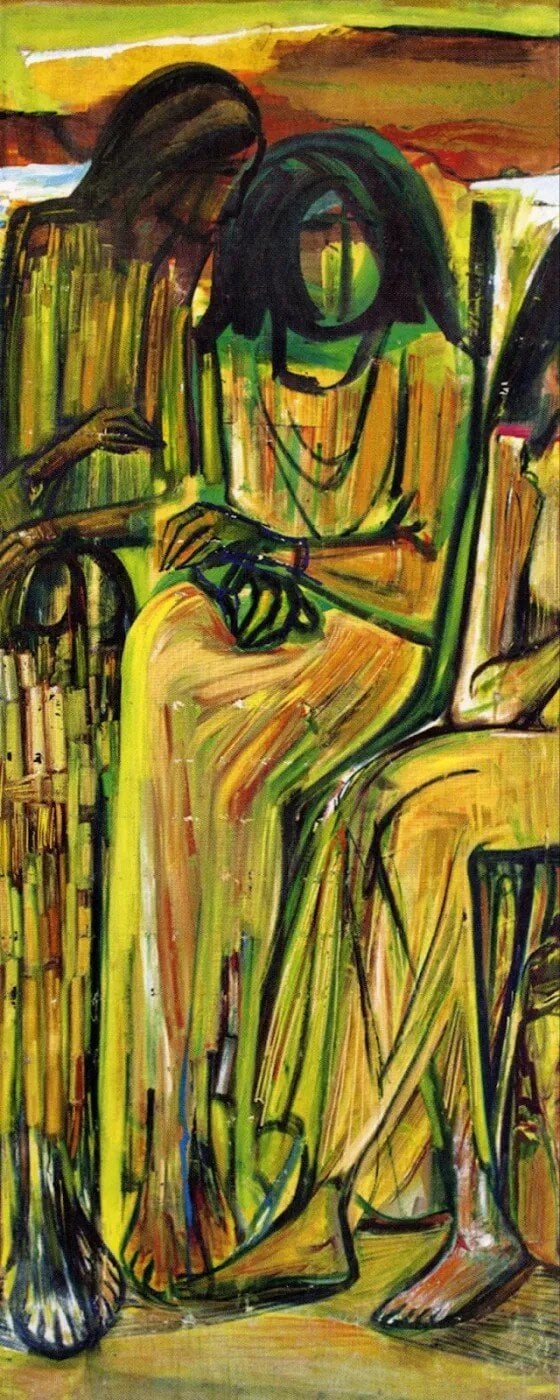By the mid-1960s, Lebanese-Armenian visual artist Paul Guiragossian became a sought-out painter and scenographer in Beirut’s thriving art scene. Guiragossian’s lifelong friend, director, and dramatist Jalal Khoury was the first to recognize his talents as a scenographer. Khoury knew of Guiragossian's theater involvement at several schools during his teaching years in the early 1950s. As such, Khoury introduced Guiragossian to promising theatre practitioners such as Chakib Khoury, Roger Assaf, and Nidal Al-Ashkar with whom Guiragossian collaborated.
Guiragossian also executed the set designs of some of Khoury's most prestigious theater productions, including The Vision of Simon Machard, in 1964, at Gulbenkian theater in Beirut, The Resistible Rise of Arturo Ui, in 1966, at Achrafieh Theater in Beirut, Souk El-Fa’aleh (Laborers Market), in 1969, and Jeha fil Quora Al-Amamiyyah, (Jehha at the Frontline Villages) in 1971 - both shown at the Baalbek Festivals Theater in Kantari, in Beirut.
In Jalal Khoury’s critical plays, Guiragossian created simple set designs, drawing from Khoury's primary influencer, German dramatist Bertolt Brecht. He produced emblematic paintings suspended as stage backdrops and introduced painted 'paravans' that he flipped depending on the scene. Furthermore, Guiragossian designed tables and chairs, which served as both furniture pieces and performance platforms.

Guiragossian's most notable collaboration was with Mouhtaraf Beirut Lil Masrah (The Beirut Theater Workshop) on their epic production Idrab Al-Haramiyyeh (The Strike of Thieves). Directed by Roger Assaf and Nidal Al-Ashkar, founders of Mouhtaraf Beirut Lil Masrah, and written by playwright Oussama Al-Aref in Arabic, the play launched on December 4, 1970, at the main hall of the Normandy Hotel in Beirut. More of a ‘grotesque’ carnival, inspired by the tales of a thousand and one night, the piece presented "a Marxist satire of the corrupt collusion of capitalism and politics within the local Lebanese context." It tells the story of people deceived and robbed by capitalist rulers who are, in turn, backed up by the local police. When the people voiced out their objection, the rulers - thieves - went on strike! Assaf and Al-Ashkar assumed leading roles in the play, while artist Waddah Fares and actor Rida Kabrit, who had put on an acrobatic performance, took secondary roles.

During that period, Assaf and Al-Ashkar were trialing innovative theater styles. So they created an arena theater within the hotel's main hall. It is comprised of three separate raised stages in the center surrounded by the audience on all sides. Challenging conventional theatre practices, Al-Ashkar then called upon Guiragossian, a progressive artist, to prepare a full-fledged exhibition reflective of the play. It was a show within a show.
Guiragossian worked insitu. He produced four monumental paintings, thirty-three small ones, and five sketches that speckled the hall's walls surrounding the audience and the stages alike. The four monumental quasi-figurative paintings including Le Cycle de la Vie, (The Circle of Life), La Guerre et la Paix,(War and Peace), and La Vie et La Joie,(Life and Joy ), also known as Antiques, depicted the interchanging nature of life and death, war and peace, and the glorious and tormented human condition. Guiragossian’s paintings were not merely reflective of the human condition, but also expressive of current political happenings.
For example, one of the mural paintings entitled Une Funeraille Historique, (A Historic Funeral) was a tribute to the Egyptian President Gamal Abdel Nasser, the father of Pan Arabism, who had passed away a couple of months before the show.
In a video interview conducted by the Dalloul Art Foundation, theater practitioner Roger Assaf described his dear friend and idol Paul Guiragossian as “a multitalented artist, poet, and philosopher." In Assaf’s words, “Guiragossian played a remarkable role in developing Beirut's art and culture scene.” Speaking about the set design of Idrab Al-Haramiyyeh, Assaf said: “At the main hall of Hotel Normandy, we created an original collaborative scenography. Paul’s expressive mural paintings placed as backdrops to the theatrical space added value to the play. Sadly, we did not develop this approach in other theatre productions. It was a unique creation that others did not attempt - at least not to my knowledge.”
Sources
Alderson, Mick. “THEATRE SPACES.” Theatre Types. Accessed September 17, 2020. https://www.ia470.com/primer/theatres.htm.
Saiid, Khalida. Al-Haraka-Al-Massrahiya-Fi-Libnan. Baalbek Festivals Committee. Arayia, Baabda: Catholic Publishers, 1998.
“Paul Guiragossian: Displacing Modernity.” Paul Guiragossian Displacing Modernity ARTBOOK | D.A.P. 2018 Catalog Silvana Editoriale Books Exhibition Catalogues 9788836639076, October 23, 2018. https://www.artbook.com/9788836639076.html.



Comments on Paul Guiragossian: Painter of Beirut’s Modern Theater